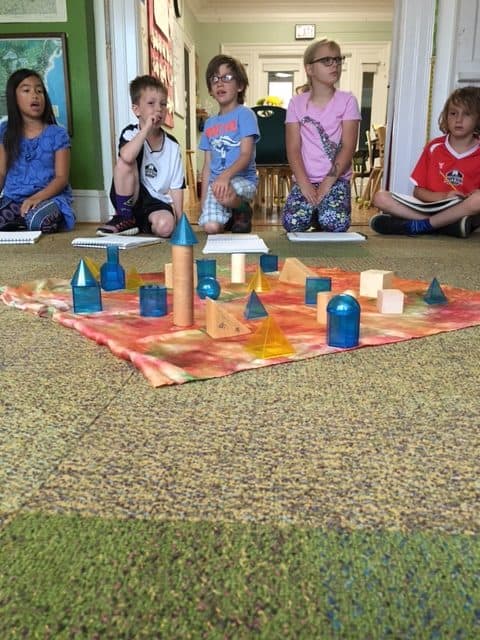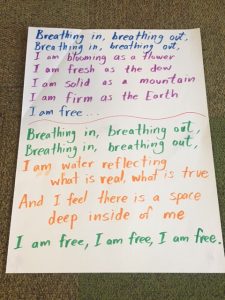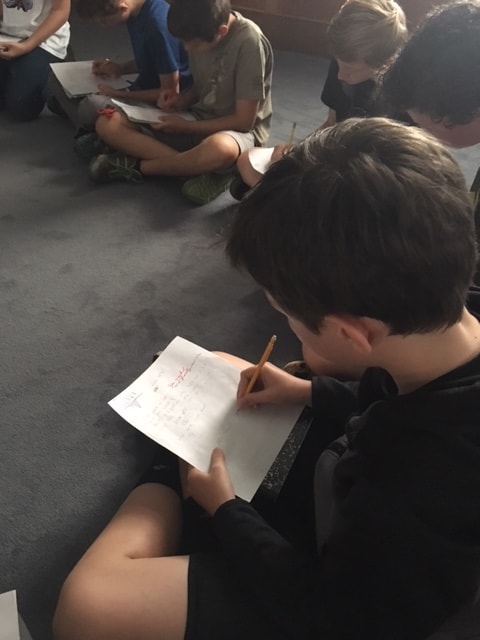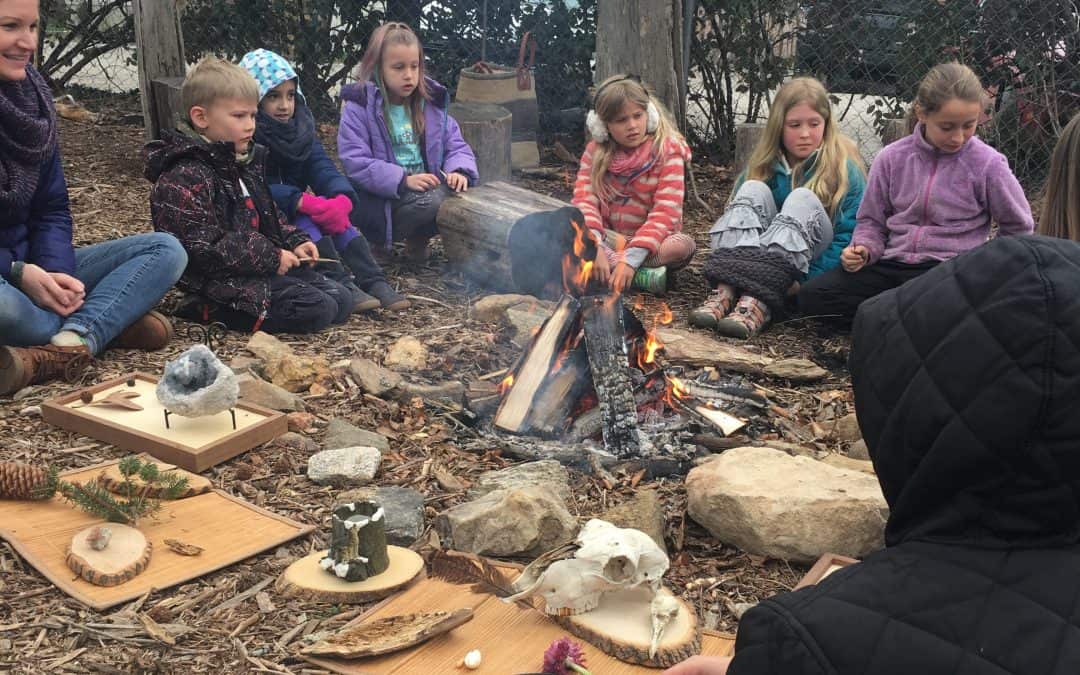
by West | Jun 16, 2017 | Alumni News & Accolades, Blogs, News, Rainbow Institute
A rite of passage is an important, sacred ceremony that highlights a transitional period in a person’s life- often marking the departure from one group in order to enter another. Graduation is one of those rites of passage and is also known as commencement, convocation or invocation.
At Rainbow, it takes on all of these forms but at its core is an invocation- this sacred ceremony serves as an invitation of the spirit, a reverence for deep connection, reflection and transformation. Our RCS graduation is one of many shared celebrations, ceremonies and rites of passage that empower students to turn both inward and outward in order to realize that they are part of an integral community as well as something greater than themselves.
As the ceremony opened, we were welcomed by the Executive Director, Renee Owen. She took a moment to acknowledge some of the RCS commencement traditions that make the ceremony sacred. She first explained that every graduating child speaks at commencement- that each child has an opportunity to share with the community a memory that they want to hold in their hearts as they move through this important transition. Their voices are heard, their memories are honored and their growth and transformation are celebrated by the entire community.
Renee went on to explain another important ritual of this rite of passage- centering. As all things at Rainbow begin with centering- from school days, to meetings, to shared celebrations- so does graduation. Renee noted that the purpose of centering is to help each of us bring a mindful awareness to the present moment. She acknowledged the profound importance of the evening’s events and reminded us that…”there will never be another moment like it ever again.”
Graduation centerings are led by the graduates. Last week at preschool graduation, four eager preschoolers lead the whole community in acts of mindful listening, deep breathing, and a blessing of compassion. Last night, seven confident 8th graders lead centering. It began with the song of the singing bowl to gather everyone’s attention. Jackson, one of our graduates who has been here since first grade, stepped up to the microphone and invited each member of the community to turn to their neighbors to greet one another. Gaby, another graduate, then followed with an invitation to close eyes and reflect on the greeting. The reflection was prompted by these questions-
“Did they look happy?”
“What color were their eyes?”
“How long was their hair?”
“What was their name?”
Lena, then approached the microphone and followed with this quote…”Life is a dance, mindfulness is witnessing that dance.” Jackson furthered explained that, “No one in life will guide you to notice the space you are in, so it is up to you to be mindful of your space and body. Now… reintroduce yourself in a centered space, pay close attention to the entire picture, and ask mindful questions.” Another student reflected, “How did that greeting make you feel this time? What more did you noticed?” Finally Harmony, another student closed the centering by leading the group in a deep, communal breath.
RCS closes this rite of passage each year with a song that has held space in this community- as a gift of appreciation- for decades. Last night, this song was meant as an enduring reminder for all the graduates that they are held, supported and deeply loved by their RCS community. Below are the simple but profound lyrics.
Dear Ones we love you, Dear Ones you helped us to grow,
There’s a circle of light around you, there’s a circle of light in your heart.
There’s a circle of love around you, there’s a circle of love in your heart.

by West | Jun 16, 2017 | Blogs, News, Rainbow Institute
Education is a sacred calling.
Bridging sacred and school is spiritual work.
A strong spiritual identity among teacher and student is the catalyst for this meaningful work.
At Rainbow, we feel that a spiritually nourished child is a child ready to learn. We know, just as students come to school with social and emotional learning needs they also show up with spirits- that are waiting to be nourished. When we intentionally invite the soul into the classroom, then we truly educate for “wholeness” by nurturing the mind, the body and the SPIRIT.
Our daily centering practices serve as one way in which we invite the “soul” in to the classroom. These spirit-honoring centerings begin in preschool and at this stage, these little learners are immersed in a world that is still very magical, mysterious and awe-inspiring. The magic is fed through community centered rituals, mindfulness practices, storytelling, art, drama, music, yoga, dance, and multicultural celebrations.The daily centering practices also provide ample opportunities to nurture empowered learners, foster independence and leadership, and celebrate community.
Recently I joined Lucy and the preschool Dragonflies for centering. On this particular morning Thomas, one of the preschoolers, served as the leader for the centering rituals. He began by asking his class to put on their mindful bodies and their mindful listening ears. He then told them that he would ring the singing bowl and wanted every person to actively and mindfully listen until they could no longer hear the song of the bell and then to raise their hand when its song was gone. He then used a breathing ball and guided his classmates in three deep inhales and exhales. As the ball expanded he said aloud “inhale” and as it contracted he said “exhale.”
Lucy, then invited the preschoolers to join her in a self-affirming morning verse that was paired with sign language. The kids spoke the words with confidence and enthusiasm… “May I be healthy, may I be strong, may I be happy, may I be peaceful.” These affirmations served as inspiration for the rest of centering.
She explained that each person would have the opportunity to choose a kind wish they have for themselves. She showed and read the kind wish cards aloud and asked to kids to be thinking about which one they wanted for themselves today. When the kids were ready to share, they signaled to Lucy by placing their thumbs on their knees. She invited each them to approach the altar which was filled with the kind wish cards, candles and the wishing water. The kids were asked to speak their kind wish and illuminate their “love light” or personal candles.
Much like plants need our care to thrive, our intentions and affirmations need that attention too. To that end, at the close of centering the Lucy explained that she would take the wishing water (filled with their wishes) and send the kind wishes in to the world by watering the plants.
If we feed our body, it can grow. If we feed our mind, it can be stimulated. If we nurture our spirit, it can flourish. What will your spirit honoring practice be today?
Your daily intention or well wish has the capacity to ripple through every aspect of your daily life. What intention or well wish do you have for yourself today?

by West | May 19, 2017 | Blogs, News, Rainbow Institute
The goals of meditation can vary from practitioner to practitioner. A practitioner may meditate to calm themselves, regulate emotions or reduce stress. They may also engage in meditation as a strategy for deep reflection, connection or intuiting. In its traditional form, it is practiced by sitting still and focusing on the breath or bodily sensations. This traditional practice shows up in Rainbow classrooms and centering practices but just as the goals of meditation vary, so can the form it takes.
At RCS, meditation takes on many shapes and often engages various learning domains. Creative meditation, for example, is explored through expressive ways such as mindful drawing or writing. Students may also embody a kinesthetic meditation by mindful walking, yoga or interpretive dance. Additionally, solo time communing with or observing nature attends to the natural domain.
Meditation at Rainbow, regardless of form begins by slowing things down, bringing awareness to the body and aligning each activity with the breath. The rituals of a 2nd grade centering often begin with a gentle reminder from their teacher, Eddy, to still their bodies, hold a silence for the candle lighting and three deep communal breaths. Eddy also recognizes the boundless physical, mental and emotional benefits of collective singing and to that end, it too has become part of these cultural rituals. Ultimately, communal singing in this reverent and celebratory way has become a meditation for these students. Simple melodies paired with profound lyrics aim to deepen the already sacred tone, nurture a transcendent experience, strengthen their bond and invite a bit of whimsy.

On this day, once the centering rituals are complete, Eddy begins describing the meditative drawing activity the students will be participating in. He explains that they will be using shapes and forms to create a collaborative sculpture, meditate on it and then draw what they see. He explains that the goal is to bring mindfulness to their observation and their drawing skills.
He invites the students to choose a three-dimensional shape from the tray and then asks them to place their shape on the silk that covers the center of the rug. This communal creation resembles a city of sorts. He prompts the kids by saying “imagine walking through this world. Let your imagination allow it to come alive, look at it from all angles, what do you see, what is around you…meditate on it.” He then rings the singing bell and tells them that when they can no longer hear the song of the bowl that will serve as their signal to begin drawing.
Eddy emphasized to the kids to just… draw what they saw. Those simple words became so freeing for the kids. Those words evoked a sense of autonomy that set the stage for a pure meditation. They were able to fully embrace the practice- free from perfectionism, free from concern for mistake making or being right over wrong. The tone of the classroom settled into a calm inquiry, a collective focus, and a creative meditation.
How can your traditional meditation practice take on a new form? Try something different today? Mindful eating, tea meditation, deep listening, walking meditation…
Make a list of 5 daily activities that you can bring some mindful presence to and take a pause for those each day. Try it for a week. What do you uncover or discover? REFLECT.

by West | May 1, 2017 | Rainbow Institute
Circles and Cycles of Gratitude
Imagine being a middle schooler again, arriving on a Friday morning, walking into a darkened, quiet room, joining the rest of your class in a circle on the floor and hearing something like this from your teacher…
Please take a moment to free up your hands, find a comfortable, seated position and bring your awareness to how your body is feeling at this moment. Whatever happened this morning, whatever is running through your mind…let it go.
Tune into your breath. Don’t attempt to change the rhythm, depth or pattern but rather just notice the ups and downs. Now, allow for your breath to lengthen…allow for a pause as you breathe out and back in. Release the stress, obstacles, challenges of the morning with an audible sigh, allow this release to let you unwind and relax.
Now, lets open the centering circle by lighting the candle.
Rituals such as these can be experienced in every RCS classroom on daily basis. They take various forms depending on the age of the students and the culture of the classroom. This sense of mindful reverence is intentionally invited into each circle of students so to pave the way for some deep exploration of self.
A theme of gratitude became the focus of this centering and the wisdom of the words by William Arthur Ward served to guide the student’s inner reflection. This William Arthur Ward quote was read aloud by Omega teacher, Mark Hanf… “Gratitude can turn a common day into a thanksgiving, turn routines jobs into joy, and change ordinary opportunities into blessings.” Mark followed by talking about the transformative power that gratitude reflections can have on your happiness and shared a personal story about how his own use a gratitude journal has had a profound influence on how he views reality. This idea of “turning a blue day into a new day” by shifting your perspective is backed by a large body of research. This research highlights using gratitude lists or journals to positively impact your mental health and well being. Below are a few articles on the subject.
Harvard Medical School
UC Davis
UC Berkeley
The remainder of the gratitude centering emphasized refelction. The Omega students took a few minutes to create gratitude lists in their centering journals and then were guided through a reflective practice in which they explored the appreciations that they have for each of their classmates. At RCS we call this a gratitude circle. Our students begin this reflective process in preschool and cycle through it in some form each year. For this particular circle each student wrote their name in the center of a piece of paper and then that paper was passed around the circle while each classmate added an appreciation.
The process felt like a solemn mediation- it was quiet, the students were focused and engaged and then as the papers were returned to their owners something truly beautiful happened- a wave of smiles, grins, giggles emerged. It was pure joy to witness the transformative power of this activity. It is a powerful practice to acknowledge those things you appreciate about yourself but it it can also be incredibly inspiring to hear them from others. Try it! Share an appreciation today!
How can what we do at RCS inspire your own personal or professional work?
Gratitude lists have tangible benefits! Try inviting them into your daily practice- Here are some helpful hints: be specific, be consistent, share your gratitudes, strive to shift your mind set- find the good in the bad.

by West | Apr 23, 2017 | Blogs, Rainbow Institute
On April 22, 2017 billions of people worldwide will commune with the Earth through a variety of celebratory activities honoring Earth Day! Earth Day, started in 1970 is the largest secular holiday- celebrated by more 193 countries. Although observed to provoke environmental awareness, action and policy changes, RCS sees Earth Day as an opportunity to pay respect to the sacred bond between nature and humanity.
Earth Day is everyday at RCS! The natural world serves as an important teacher in the lives of all our students. This connection is emphasized in our mission to “develop accomplished, confident, and creative learners who are prepared to be compassionate leaders in building a socially just, spiritually connected, and environmentally sustainable world” and serves as one of our 12 guiding principles “through understanding nature we understand ourselves therefore the learning environment extends into the natural world, the greater community. A relationship with Nature yields stewardship.”
The natural domain is also one of the Seven RCS Learning Domains that shapes our holistic model. Growth and development in the natural domain is nurtured through various learning experiences that become part of daily routines and rituals. Please see the table below for the learning goals and descriptors.

We also strive to nurture deep nature-student relationships through various nature based centering practices that emphasize this spiritual learning goal:
Communion with the natural world: Understanding our interconnection with the natural world. Cultivating a reverence for Life. The Natural World serves as our teacher and guide as we explore our inner selves.
Additionally, RCS’s mascot happens to be The Rainbow Warrior. The legend of the Rainbow Warrior names the warrior as a protector of Mother Earth. In this legend, there will come a day when people of all races, colors, and creeds will put aside their differences and will band together- unified. Like the colors of the rainbow, they will move over the Earth like a great Whirling Rainbow, bringing peace, understanding and healing everywhere they go. Creatures thought to be extinct or mythical will resurface at this time. Great trees that perished will return almost overnight. All living things will flourish. If you wish to read more about why we chose the Rainbow Warrior as our mascot and the legend in full please click here.
Everyday at RCS is Earth day. This incredible reverence and respect for the natural world permeates our curriculum and our culture. We all have a stake in caring for this Earth – is some cases it is a religious value, in others a moral responsibility or a matter of equity. The RCS holistic model specifically emphasizes nurturing environmental stewards that have a intimate, empathic and sacred connection with the Earth. It is through this empathy and connection from which they solve environmental problems. Additionally, by cultivating a sense of the divine or sacred in nature than it has the power to become a life-long spiritual teacher.















